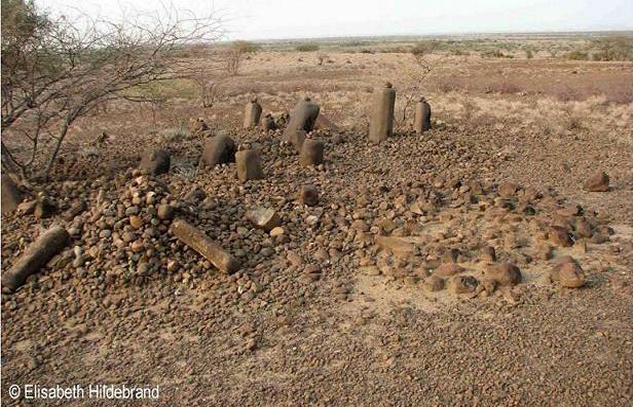









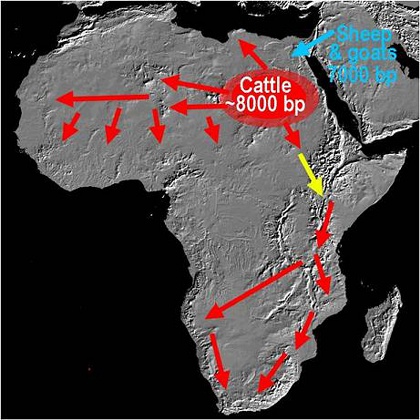

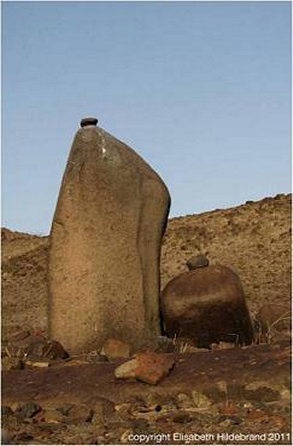
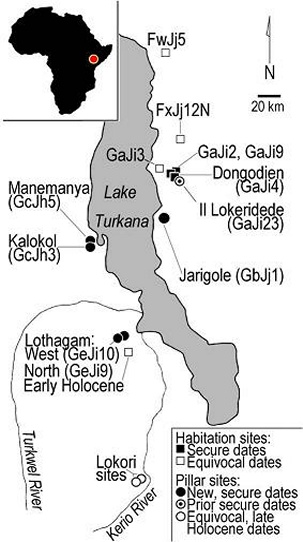
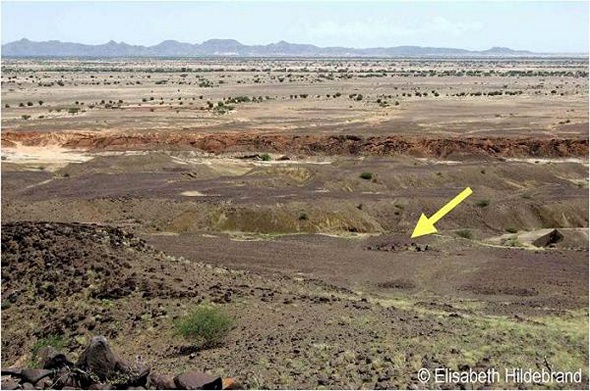
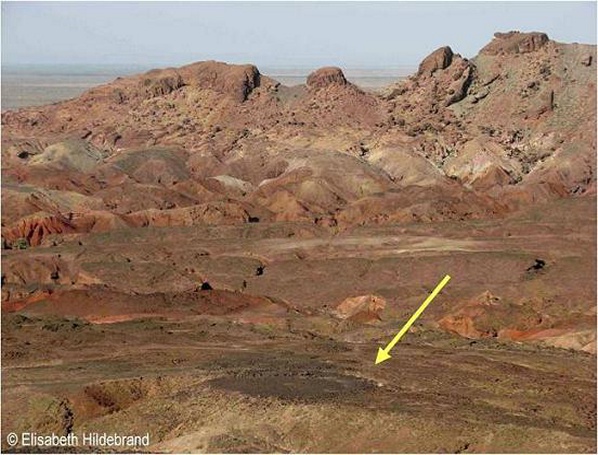
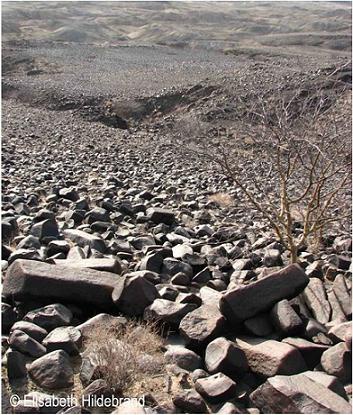

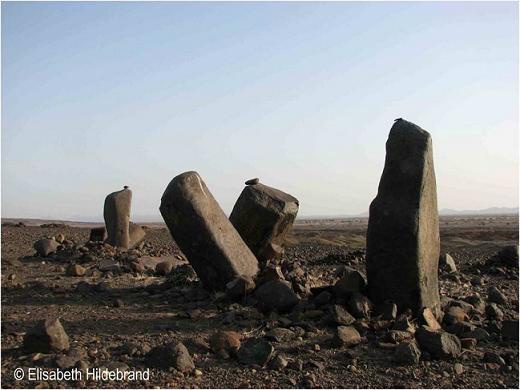
Cattle before crops
Unlike most parts of the world, where farming preceded or co-occurred with animal husbandry,
Africa saw herding established before farming.
Studying early herding is important for several reasons. First, it allows us to understand how human societies change if their first act of food production is animal- rather than plant-related. Second, herders’ frequent movements may have delayed the steady selection pressures that would result in plant domestication.
Unlike most parts of the world, where farming preceded or co-occurred with animal husbandry,
Africa saw herding established before farming.
Studying early herding is important for several reasons. First, it allows us to understand how human societies change if their first act of food production is animal- rather than plant-related. Second, herders’ frequent movements may have delayed the steady selection pressures that would result in plant domestication.
The origin and spread of herding in Africa
After African cattle were domesticated in the eastern Sahara around 8000 years ago, and sheep and goats crossed the Sinai from southwest Asia 7000 years ago, the practice of herding became common across grasslands in northern Africa. As rainfall decreased and the Sahara desert emerged, herding spread south to still-wetter areas. Positioned between the highlands of Ethiopia, and heavily forested areas of central Africa, the Turkana Basin (yellow arrow) would have been a corridor for the spread of herding from northern Africa to southern and eastern portions of the continent.
After African cattle were domesticated in the eastern Sahara around 8000 years ago, and sheep and goats crossed the Sinai from southwest Asia 7000 years ago, the practice of herding became common across grasslands in northern Africa. As rainfall decreased and the Sahara desert emerged, herding spread south to still-wetter areas. Positioned between the highlands of Ethiopia, and heavily forested areas of central Africa, the Turkana Basin (yellow arrow) would have been a corridor for the spread of herding from northern Africa to southern and eastern portions of the continent.
Early herding and monumental architecture
In several parts of Africa, it appears that early herders made important innovations in social life, including monumental architecture (megalithic construction), and cemeteries that show differentiation in social status and/or point to elaborate mortuary customs. The Turkana Basin is no exception: Megalithic “pillar sites” found in the area have long been attributed to early herders, but saw little research and almost no radiometric dating until recently.
Documenting the timing of pillar site construction relative to early herding, and the social purposes that Turkana Basin pillar sites fulfilled, is vital to understanding the sorts of social changes that accompanied the start of food production in different parts of Africa.
In several parts of Africa, it appears that early herders made important innovations in social life, including monumental architecture (megalithic construction), and cemeteries that show differentiation in social status and/or point to elaborate mortuary customs. The Turkana Basin is no exception: Megalithic “pillar sites” found in the area have long been attributed to early herders, but saw little research and almost no radiometric dating until recently.
Documenting the timing of pillar site construction relative to early herding, and the social purposes that Turkana Basin pillar sites fulfilled, is vital to understanding the sorts of social changes that accompanied the start of food production in different parts of Africa.
Above: Pillars at GeJi10 (Lothagam West)
Right: Pillars (left) and cairn (right) at GcJh3 (Kalokol Pillar site). Lake Turkana is at the horizon.
Right: Pillars (left) and cairn (right) at GcJh3 (Kalokol Pillar site). Lake Turkana is at the horizon.
History of research
Larry Robbins did fieldwork focusing on Holocene archaeology west of Lake Turkana in the 1960s and 1970s. He found many sites, and did extensive excavation of an early Holocene fishing-hunting-gathering site at Lothagam.
John Barthelme undertook parallel investigations east of Lake Turkana in the 1970s and 1980s. His surveys yielded numerous fishing-hunting-gathering sites, as well as at least two sites with definitive evidence for use of domestic cattle and caprines around 4000 years ago.
Harry Merrick and Charles Nelson excavated Jarigole, a megalithic “pillar site” on the east side of the lake, in the early 1990s.
Key issues
Although we now know when domestic stock arrived near Lake Turkana, some human dimensions of early herding in this area are not very clear:
Larry Robbins did fieldwork focusing on Holocene archaeology west of Lake Turkana in the 1960s and 1970s. He found many sites, and did extensive excavation of an early Holocene fishing-hunting-gathering site at Lothagam.
John Barthelme undertook parallel investigations east of Lake Turkana in the 1970s and 1980s. His surveys yielded numerous fishing-hunting-gathering sites, as well as at least two sites with definitive evidence for use of domestic cattle and caprines around 4000 years ago.
Harry Merrick and Charles Nelson excavated Jarigole, a megalithic “pillar site” on the east side of the lake, in the early 1990s.
Key issues
Although we now know when domestic stock arrived near Lake Turkana, some human dimensions of early herding in this area are not very clear:
• Whether herding spread via migration of human groups, down-the-line adoption, or
some combination of both;
• How social lives changed as herding became common;
• Whether "pillar sites" in various locations around Lake Turkana were built by early herders, or hunter-gatherers.
some combination of both;
• How social lives changed as herding became common;
• Whether "pillar sites" in various locations around Lake Turkana were built by early herders, or hunter-gatherers.
Above: View west from Lothagam Ridge past pillar site GeJi10 to Napadet Hills.
Below: View of GeJi9 from the western Lothagam Ridge. Platform in foreground is 30 m in diameter.
Below: View of GeJi9 from the western Lothagam Ridge. Platform in foreground is 30 m in diameter.
Pillar site research
Four pillar sites have been located on the western side of Lake Turkana, near major basalt ridges such as the Losedok Hills (north) and Lothagam (south). The sites are distributed in pairs. Under my direction, the Later Prehistory of West Turkana Project undertook the first test excavations at these four sites in 2008 and 2009.
The sites vary in architectural elements, size, and layout. The largest and most architecturally complex is GeJi9, located inside the Lothagam complex. It has a platform 30 m in diameter, and 15 stone circles and cairns to the east. Other sites are smaller, and have fewer associated carins and stone circles
Test excavations showed that artifact assemblages also vary among the four sites as well. Only two of the sites, GeJi9 and GcJh5, have beads and Nderit pottery, a ceramic tradition with very elaborate decorations. The other two sites have scant artifact assemblages. All four have stone tools, but raw materials vary from site to site.
Four pillar sites have been located on the western side of Lake Turkana, near major basalt ridges such as the Losedok Hills (north) and Lothagam (south). The sites are distributed in pairs. Under my direction, the Later Prehistory of West Turkana Project undertook the first test excavations at these four sites in 2008 and 2009.
The sites vary in architectural elements, size, and layout. The largest and most architecturally complex is GeJi9, located inside the Lothagam complex. It has a platform 30 m in diameter, and 15 stone circles and cairns to the east. Other sites are smaller, and have fewer associated carins and stone circles
Test excavations showed that artifact assemblages also vary among the four sites as well. Only two of the sites, GeJi9 and GcJh5, have beads and Nderit pottery, a ceramic tradition with very elaborate decorations. The other two sites have scant artifact assemblages. All four have stone tools, but raw materials vary from site to site.
Above: View from a helicopter over GeJi9, showing the platform (left side) and cairns and
stone circles (right side)
All four sites yielded datable material that allowed our team to obtain the first
radiometric dates for pillar sites in this area. The dates are all close to 4000 years
ago, overlapping with each other and with the dates on the earliest domestic stock
in the Turkana Basin. Thus, while it is not yet clear whether early herders actually
built the pillar sites, it is clear that construction took place around the time that
herding was first practiced locally. As domestic animals became part of the local
economic landscape, many social and economic roles would have been shifting. It
is possible that pillar sites - and the social activities they served - helped mediate
some of these changes.
Above: Source for basalt pillars on west slope of Lothagam
Ridge. Pillars were hauled up to 2 km from source to site.
Investigations at the West Turkana pillar sites will
continue in 2012 and 2013, with funds from the
National Science Foundation. The team will also
survey for habitation sites in nearby areas.
Early herding & public architecture in northwest Kenya
The spread of herding from the eastern Sahara to other parts of Africa.
Above: Archaeological sites relevant to early herding and
monumental architecture around Lake Turkana.
Above: Upright pillars at GeJi10
Publications on the spread of food production in Africa
Marshall, Fiona and Elisabeth Hildebrand. 2002. Cattle before crops: The beginnings of food production in Africa. Journal of World Prehistory 16(2):99-143.
Publications on early herding and monumental architecture in northwest Kenya
Elisabeth Hildebrand, John Shea and Katherine Grillo. 2011. Four middle Holocene pillar sites in West Turkana, Kenya. Journal of Field Archaeology 36(3):181-200.
Elisabeth Hildebrand and Katherine Grillo. In press. Early herders and monumental sites in eastern Africa: Dating and interpretation. Antiquity, to be published in July 2012.
Marshall, Fiona and Elisabeth Hildebrand. 2002. Cattle before crops: The beginnings of food production in Africa. Journal of World Prehistory 16(2):99-143.
Publications on early herding and monumental architecture in northwest Kenya
Elisabeth Hildebrand, John Shea and Katherine Grillo. 2011. Four middle Holocene pillar sites in West Turkana, Kenya. Journal of Field Archaeology 36(3):181-200.
Elisabeth Hildebrand and Katherine Grillo. In press. Early herders and monumental sites in eastern Africa: Dating and interpretation. Antiquity, to be published in July 2012.
Future research







